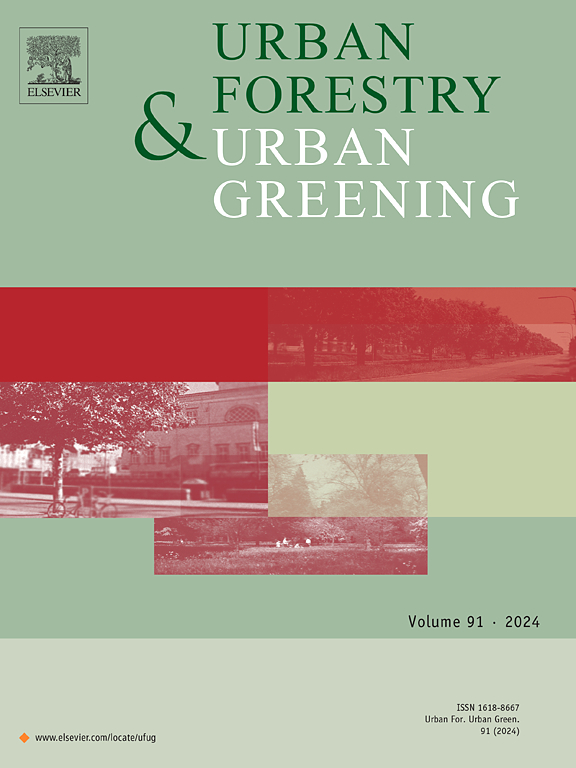城市景观植物耐火性多维综合评价:弹性绿化策略框架
IF 6
2区 环境科学与生态学
Q1 ENVIRONMENTAL STUDIES
引用次数: 0
摘要
在气候变化的背景下,城市地区面临着不断升级的野火风险,选择防火植被对于可持续和有弹性的景观规划至关重要。然而,大多数先前的研究使用一维方法,忽略了影响植物可燃性的形态、物理化学和燃烧特性之间复杂的相互作用。本研究引入了一个新的多维度评价框架,系统地整合了这些不同的与火有关的特征,以评估上海44种常用城市植物的耐火性。通过应用critical (Criteria Importance Through Intercriteria Correlation)加权法,我们客观地量化了树木、灌木、草本和藤本植物中22个与火灾相关指标的相对重要性。结果表明,影响木本植物相对草本植物和藤本植物耐火性的关键因素各不相同。具体来说,燃烧时间在木本物种的耐火性中起关键作用,而粗脂肪和水分含量等理化性状是灌木和草本物种的强预测因子。根据综合耐火性评价分数,将研究植物分为4类。高抗火性的树种有荆芥、山茱萸和西洋参。此外,我们的分类揭示了不同植物生长形式的耐火性差异,为选择物种建立安全和可持续的景观配置提供了科学依据。该框架填补了文献中方法论上的空白,并为将防火纳入城市绿化战略提供了可扩展的工具,有助于气候适应、生态安全和长期城市韧性。本文章由计算机程序翻译,如有差异,请以英文原文为准。
Comprehensive Multi-Dimensional Evaluation of Fire Resistance in Urban Landscape Plants: A Framework for Resilient Greening Strategies
As urban areas face escalating wildfire risks under climate change, selecting fire-resistant vegetation has become vital for sustainable and resilient landscape planning. Yet, most prior studies use one-dimensional approaches and overlook the complex interactions among morphological, physicochemical, and combustion traits that influence plant flammability. This study introduces a novel, multi-dimensional evaluation framework that systematically integrates these diverse fire-related traits to assess the fire resistance of 44 commonly used urban plant species in Shanghai, China. By applying the CRITIC (Criteria Importance Through Intercriteria Correlation) weighting method, we objectively quantified the relative importance of 22 fire-related indicators across trees, shrubs, herbaceous, and vines plants. The results indicate distinct key factors influencing the fire resistance of woody plants versus herbaceous and vine. Specifically, combustion duration plays a critical role in the fire resistance of woody species, while physicochemical traits such as crude fat and moisture content are strong predictors for shrubs and herbaceous forms. Based on comprehensive fire resistance evaluation scores, the studied plants were classified into four categories. Species with high fire resistance include Platanus × acerifolia , Aucuba japonica var. variegata and Parthenocissus quinquefolia . Additionally, our classification reveals marked differences in fire resistance across plant growth forms, offering a scientific basis for selecting species to establish safe and sustainable landscape configurations. The proposed framework fills a methodological gap in the literature and provides a scalable tool for integrating fire prevention into urban greening strategies, contributing to climate adaptation, ecological safety, and long-term urban resilience.
求助全文
通过发布文献求助,成功后即可免费获取论文全文。
去求助
来源期刊

Urban Forestry & Urban Greening
FORESTRY-
CiteScore
11.70
自引率
12.50%
发文量
289
审稿时长
70 days
期刊介绍:
Urban Forestry and Urban Greening is a refereed, international journal aimed at presenting high-quality research with urban and peri-urban woody and non-woody vegetation and its use, planning, design, establishment and management as its main topics. Urban Forestry and Urban Greening concentrates on all tree-dominated (as joint together in the urban forest) as well as other green resources in and around urban areas, such as woodlands, public and private urban parks and gardens, urban nature areas, street tree and square plantations, botanical gardens and cemeteries.
The journal welcomes basic and applied research papers, as well as review papers and short communications. Contributions should focus on one or more of the following aspects:
-Form and functions of urban forests and other vegetation, including aspects of urban ecology.
-Policy-making, planning and design related to urban forests and other vegetation.
-Selection and establishment of tree resources and other vegetation for urban environments.
-Management of urban forests and other vegetation.
Original contributions of a high academic standard are invited from a wide range of disciplines and fields, including forestry, biology, horticulture, arboriculture, landscape ecology, pathology, soil science, hydrology, landscape architecture, landscape planning, urban planning and design, economics, sociology, environmental psychology, public health, and education.
 求助内容:
求助内容: 应助结果提醒方式:
应助结果提醒方式:


